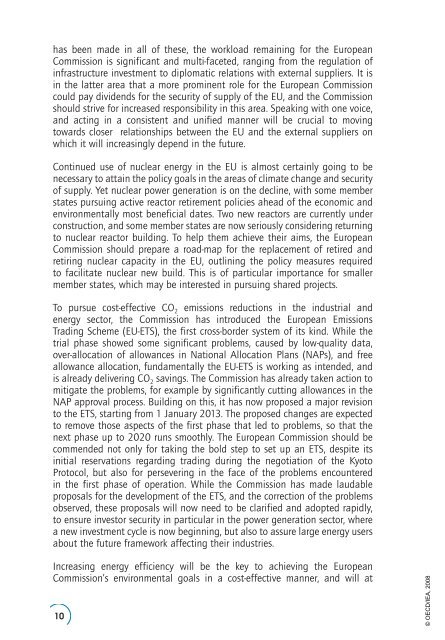executive summary and key recommendations - European ...
executive summary and key recommendations - European ...
executive summary and key recommendations - European ...
Create successful ePaper yourself
Turn your PDF publications into a flip-book with our unique Google optimized e-Paper software.
has been made in all of these, the workload remaining for the <strong>European</strong><br />
Commission is significant <strong>and</strong> multi-faceted, ranging from the regulation of<br />
infrastructure investment to diplomatic relations with external suppliers. It is<br />
in the latter area that a more prominent role for the <strong>European</strong> Commission<br />
could pay dividends for the security of supply of the EU, <strong>and</strong> the Commission<br />
should strive for increased responsibility in this area. Speaking with one voice,<br />
<strong>and</strong> acting in a consistent <strong>and</strong> unified manner will be crucial to moving<br />
towards closer relationships between the EU <strong>and</strong> the external suppliers on<br />
which it will increasingly depend in the future.<br />
Continued use of nuclear energy in the EU is almost certainly going to be<br />
necessary to attain the policy goals in the areas of climate change <strong>and</strong> security<br />
of supply. Yet nuclear power generation is on the decline, with some member<br />
states pursuing active reactor retirement policies ahead of the economic <strong>and</strong><br />
environmentally most beneficial dates. Two new reactors are currently under<br />
construction, <strong>and</strong> some member states are now seriously considering returning<br />
to nuclear reactor building. To help them achieve their aims, the <strong>European</strong><br />
Commission should prepare a road-map for the replacement of retired <strong>and</strong><br />
retiring nuclear capacity in the EU, outlining the policy measures required<br />
to facilitate nuclear new build. This is of particular importance for smaller<br />
member states, which may be interested in pursuing shared projects.<br />
To pursue cost-effective CO 2 emissions reductions in the industrial <strong>and</strong><br />
energy sector, the Commission has introduced the <strong>European</strong> Emissions<br />
Trading Scheme (EU-ETS), the first cross-border system of its kind. While the<br />
trial phase showed some significant problems, caused by low-quality data,<br />
over-allocation of allowances in National Allocation Plans (NAPs), <strong>and</strong> free<br />
allowance allocation, fundamentally the EU-ETS is working as intended, <strong>and</strong><br />
is already delivering CO 2 savings. The Commission has already taken action to<br />
mitigate the problems, for example by significantly cutting allowances in the<br />
NAP approval process. Building on this, it has now proposed a major revision<br />
to the ETS, starting from 1 January 2013. The proposed changes are expected<br />
to remove those aspects of the first phase that led to problems, so that the<br />
next phase up to 2020 runs smoothly. The <strong>European</strong> Commission should be<br />
commended not only for taking the bold step to set up an ETS, despite its<br />
initial reservations regarding trading during the negotiation of the Kyoto<br />
Protocol, but also for persevering in the face of the problems encountered<br />
in the first phase of operation. While the Commission has made laudable<br />
proposals for the development of the ETS, <strong>and</strong> the correction of the problems<br />
observed, these proposals will now need to be clarified <strong>and</strong> adopted rapidly,<br />
to ensure investor security in particular in the power generation sector, where<br />
a new investment cycle is now beginning, but also to assure large energy users<br />
about the future framework affecting their industries.<br />
Increasing energy efficiency will be the <strong>key</strong> to achieving the <strong>European</strong><br />
Commission’s environmental goals in a cost-effective manner, <strong>and</strong> will at<br />
10<br />
© OECD/IEA, 2008
















